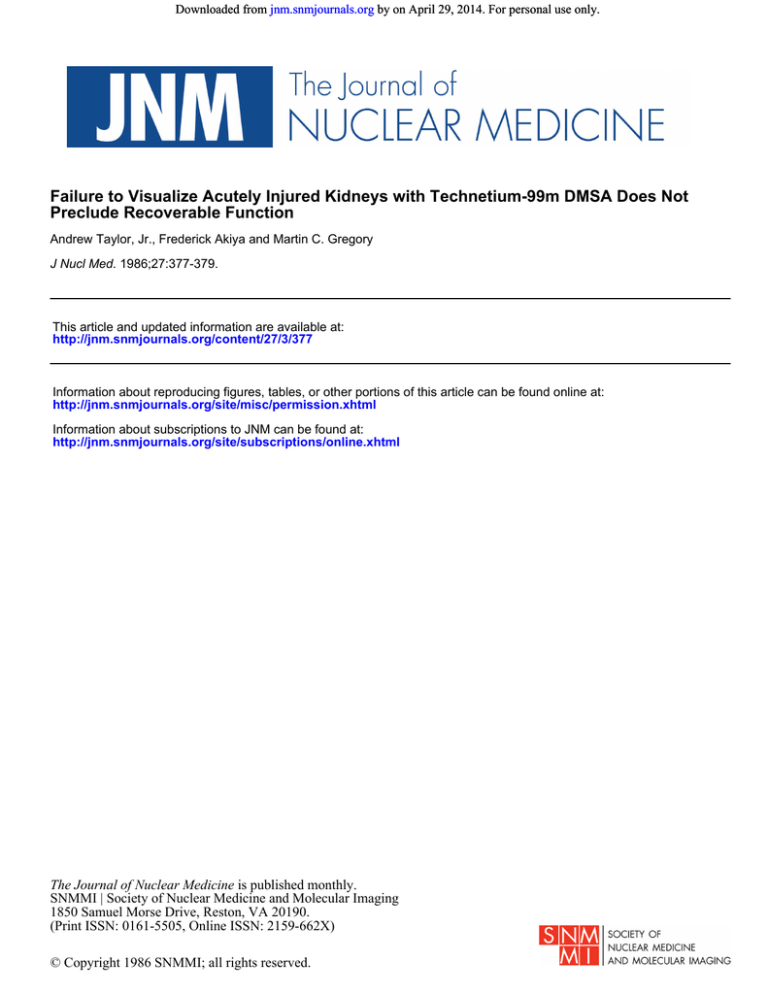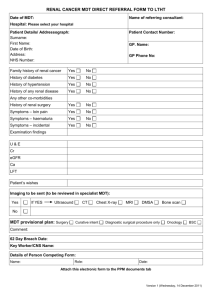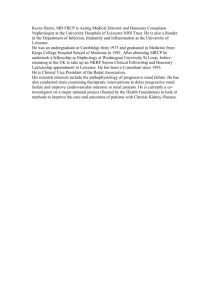
Downloaded from jnm.snmjournals.org by on April 29, 2014. For personal use only.
Failure to Visualize Acutely Injured Kidneys with Technetium-99m DMSA Does Not
Preclude Recoverable Function
Andrew Taylor, Jr., Frederick Akiya and Martin C. Gregory
J Nucl Med. 1986;27:377-379.
This article and updated information are available at:
http://jnm.snmjournals.org/content/27/3/377
Information about reproducing figures, tables, or other portions of this article can be found online at:
http://jnm.snmjournals.org/site/misc/permission.xhtml
Information about subscriptions to JNM can be found at:
http://jnm.snmjournals.org/site/subscriptions/online.xhtml
The Journal of Nuclear Medicine is published monthly.
SNMMI | Society of Nuclear Medicine and Molecular Imaging
1850 Samuel Morse Drive, Reston, VA 20190.
(Print ISSN: 0161-5505, Online ISSN: 2159-662X)
© Copyright 1986 SNMMI; all rights reserved.
Downloaded from jnm.snmjournals.org by on April 29, 2014. For personal use only.
Failure to Visualize Acutely Injured
Kidneys with Technetium-99m DMSA
Does Not Preclude Recoverable Function
Andrew Taylor, Jr., Frederick Akiya, and Martin C. Gregory
University ofUtah
School ofMedicine,
Salt Lake City, Utah
A 35-yr-old patient develOped severe acute tUbularnecrosis requiring hemod@ysis. A
[99@Tc]dimercaptosuccinic acid scan of the kidneys showed no renal uptake at 4 or 24 hr, but the
patient subsequently recovered normal renal function as judged by a normal serum creatinine.
Based on this case report and a review of the literature, one cannot assume irreversible loss of
function in patients with acute renal failure, based on the absence of rediopharmaceutical uptake
by the kidneys.
J Nucl Med 27:377—379,1986
e relative renal uptake of technetium-99m dimer
captosuccinic acid ([99mTc]DMSA), a renal cortical
imaging agent, parallels the relative renal function as
determined by the glomerular filtration rate (GFR) or
the effective renal plasma flow (ERPF) (1—6).Kawa
mura has suggested that the renal uptake ofDMSA can
actually be taken as a measure of absolute renal func
tion (7). DMSA uptake is significantly decreased in the
obstructed kidney and uptake may improve following
reliefofobstruction (8,9); however, animal studies sug
gest that little functional recovery can be expected if the
renal uptake is <4% (10). The failure to visualize a
kidney using a radiopharmaceutical is generally ac
cepted as a poor prognostic sign (10—13).In this report,
we describe a patient with acute tubular necrosis 5cc
ondary to ischemia. Although a [99mTc]DMSA scan
failed to visualize the kidneys, the patient received
hemodialysis and she subsequently recovered normal
renal function.
she bled profusely from her vagina; her blood pressure and
pulse were undetectable for 30-40 mm. She was rapidly
infused with whole blood and underwent an emergency supra
cervical hysterectomy which was complicated by massive
bleeding and oozing. She continued to bleed postoperatively
during which time her systolic blood pressure ranged from
40-60 mmHg. She returned to the operating room for a
bilateral hypogastric artery ligation and later for oversewing
of bleedingsites.Duringthe 3 days followingonsetof hemor
rhage, her urine output fell to 8- 10 cc/hr and she was trans
ferred to our medical center, having received a total of 46
units of blood.
On admission, the patient was comatose, anuric, and suf
fered from diffuse intravascular
coagulopathy
and acute res
piratory distress syndrome. Her blood pressure was 80/50
mmHg. She was placed on a ventilator, hemodialysis was
initiated, and she was treated with i.v. amikacin and chloram
phenicol for methicillin-resistant S. aureus sepsis. Multiple
intra-abdominal hematomas were found by computed tomog
raphy and ultrasound; two were drained surgically. No hema
tomas were observed in the retroperitoneal region, nor was
there any evidence of obstructive uropathy.
CASE REPORT
A 35-yr-oldprimagravidawas admitted to an outsidehos
pital for labor induction following spontaneous rupture of
membranes. She received 2 days of i.v. oxytocin and was given
intravaginal prostaglandin. On the morning of the third day,
Received June 21, 1985; revision accepted Nov. 7, 1985.
For reprints contact: Andrew Taylor, Jr., MD, Director of Nuclear
Medicine, University ofUtah School of Medicine, 50 North Medical
Dr., Salt Lake City, UT 84132.
Volume 27 •
Number 3 •
March 1986
A [99mTc]DMSAscan was performedon the 18th medical
center hospital day to evaluate possible causes for her persist
ing renal failure. At the time, the patient was still on dialysis
and her BUN and creatinine were 132 and 5.4 mg/dl, respec
tively. The 4-hr scan showed no DMSA uptake in the region
of the renal fossae, but a posterior 24-hr scan demonstrated
curvilinear activity in the left upper quadrant which initially
suggested unilateral renal uptake (Fig. 1). An anterior view
indicated that the acitivity might be in the stomach and this
hypothesis was confirmed by imaging the stomach after in
stilling 0.5 mCi of [99mTcjpertechnetate in 100 ml of water
377
Downloaded from jnm.snmjournals.org by on April 29, 2014. For personal use only.
a.'
FIGURE2
Anterior 24-hr DMSAimage enhanced by computer (left)
shows unilateral activity to be in area of stomach. Liver and
small bowel activity are also visualized. Patient stayed In
same position and swallowed 100 ml of water containing
0.5 mCi of [99―Tcjpertechnatata.Resulting image (right)
shows esophagus and stomach. Stomach activity exactly
corresponded to 99r@@Tc
activity noted on 24-hr anterior
[@Tc]DMSA image
FIGURE 1
showed that this kidney contributed 20% of the total
renal uptake.
Technetium-99m penicillarnine (TPEN) is a renal
cortical imaging agent similar to DMSA and we have
shown that minimal TPEN uptake in an acutely ob
structed canine kidney does not preclude substantial
(Fig. 2) into the stomach by way of the patient's nasogastric
tube.
recovery (14—16).Sherman and Blaufox described four
As activity in the stomach was not present on the 4-hr patients with obstructive renal failure whose kidneys
image and there was no evidence of bleeding in the stomach at failed to accumulate iodine-131 (‘@
I)‘
hippurate, yet
the time of the scan, we assume the stomach activity was due the kidneys recovered some function after relief of oh
to in vivo breakdown of [99mTc]DMSA with free [99mTc]per@ struction (13). In contrast to these results, little renal
technetate accumulating in the stomach.
function can be regained in rats with unilateral ureteral
Posterior 24-hr [99@―TcJDMSA
scan shows left upper quad
rant activity which initially suggested unilateral renal
visualization
Shortly after the initial [99mTc]DMSA scan was per
formed, the patient regained consciousness, and was eventu
ally weaned from her respirator. A second [99mTc]DMSA
scan was performed on the 24th medical center hospital day
while the patient was still on dialysis. At this time, the pa
tient's BUN was 86, her creatinine was 5.8, and her urine
output
had increased
to 460 ml/24 hr. The 24-hr
[99mTc]DMSA scan clearly demonstrated bilateral renal ac
tivity (Fig. 3). Dialysis was terminated on the 38th hospital
day and the patient was discharged on the 68th hospital day
with a BUN of 29 and a creatinine of I .2 mg/dl. Two years
later the plasma creatinine remains within the normal range.
DISCUSSION
Kidneys which fail to accumulate a radiopharmaceu
tical rarely recover useful function (10—13), although
partial recovery may occur after relief of urinary ob
struction even if uptake of tracer was very poor or even
absent during the period of obstruction (9, 10, 13, 16).
Chishoim (9) described a patient with unilateral ob
struction and no uptake of [99mTc]DTPA (diethylene
triaminepentaacetic acid) in the obstructed kidney; a
DMSA scan immediately following surgical relief of
obstruction showed some uptake in the previously ob
structed kidney and a repeat DMSA scan 20 mo later
378
Taylor,
Akiya,andGregory
FIGURE3
Second 24-hr posterior
[9@―1'c]DMSAscan clearly
demonstrates bilateral renal activity
The Journal of Nuclear Medicine
Downloaded from jnm.snmjournals.org by on April 29, 2014. For personal use only.
obstruction
once the uptake
of [99mTcIDMSA
falls
below 4% (10).
If renal failure is caused by acute tubular necrosis
(ATN) even less information is available. There were
seven patients with ATN in Sherman and Blaufox's
6.
accumulate [99mTc]DTPA and proved to have renal
infarction. The three patients with ATN did accumu
late DTPA and subsequently recovered. In our patient
with ATN normal renal function was restored, despite
failure, at one point, to visualize the kidneys with
7.
I.
Taylor A: Delayed scanning of DMSA: A simple index
of relative renal plasma flow. Radiology 136:449—451,
I 980
2. Holten I, Storm HH: Kidney scintigraphy with Tc
99m-DMSAand I-I31-hippurate.Scand J UrolNeph
3.
ro/13:275—281,
1979
Daly Mi, Henry RE: Defining renal anatomy and func
tion with Tc-99m-DMSA: Clinical and renographic
correlation. J Uro/ 126:5—9,1981
4. Daly Mi, Jones W, Rudd TG, et al: Differential renal
function using Tc-DMSA; in-vitro correlation. J Nuc/
Powers TA, Stone Wi, Grove B, et al: Radionuclide
measurementof differential GFR. Invest Radiol
16:59—64,
1981
Volume 27 •Number 3 •March 1986
Kawamura J, Hosokawa 5, Fujita T, et al: Validity of
renal function. J Urol I 19:305—309,1978
8.
Taylor A, Lallone R: Differential
renal function in uni
lateral renal injury: Possible effects of radiopharmaceu
tical choice. J Nucl Med 26:77-80,
9.
1985
Chisholm GD, Chibber Pi, Wallace DMA, Ct al:
DMSA scan and the predictionof recoveryin obstruc
tive uropathy. Eur Uro/ 8:227—230, 1982
10. Shelfhout W, Simons M, Oosterlink W, et al: Evalua
tion of Tc-99m-DMSA renal uptake as an index of
individual kidney function after acute ureteral obstruc
tion and desobstruction: An experimental study in rats.
Eur Urol9:221-226,1983
11. Romero R, Caralps A, Brulles A, et al: The significance
of the absence of 1-131 hippuran uptake by a kidney
graft. Nephron 39:306—308, 1985
I 2.
Becker iA, Kutcher R, Solomon N: The radiology of
renal failure. In Strategy in Renal Failure, Friedman
EA, ed. New York, John Wileyand Sons, 1978
13. Sherman RA, Blaufox MD: Obstructive uropathy in
patients with nonvisualization on renal scan. Nephron
14.
25:82—86,
1980
Taylor A, Davis G, Halpern 5, et al: Technetium-99m
penicillamine: A renal cortical scanning agent. J Urol
117:418-420,
1977
I5. Taylor A, Talner LB. Davis G: Technetium-99m peni
Med2O:63-66, 1979
5.
J Nucl Med
Tc-DMSA renal uptake for assessment of individual
DMSA.
REFERENCES
by Tc-DMSA
imaging and ureteral catheterization.
19:721, 1978 (abstr)
series: none accumulated [1311]hippurateand all died
(13). In a recent study (11) ten of 150 renal allografts
showed no uptake of [‘31I]hippurate in the immediate
postoperative period. Of these, seven grafts failed to
Born ML, Grove RB, Jones JP, et al: Comparison of
differential renal function determination
I 6.
cillamine scans: An index ofdifferential renal failure. J
Uro/ 120:142-144,
1978
Talner LB, Sokoloffi, Halpern SE, et al: Limitations of
renal functional scanning in acute obstruction. mt. J
NuclMedBiol9:181—187,
1982
379








